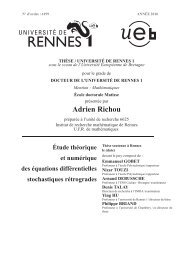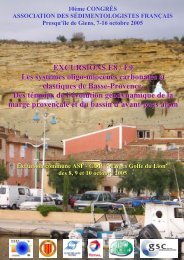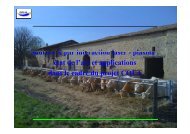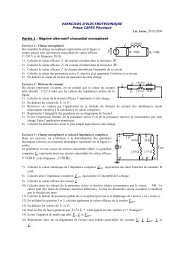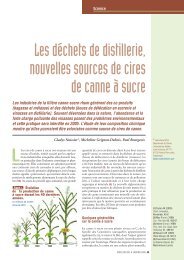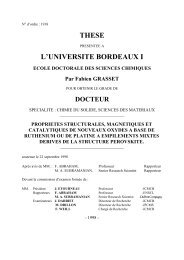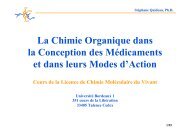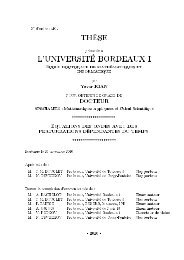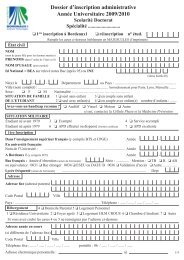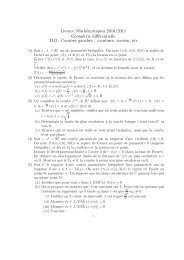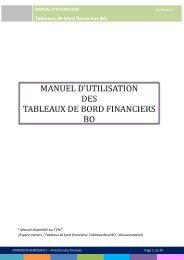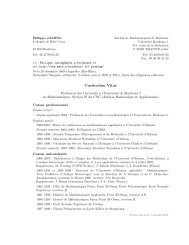Number Theory
Number Theory
Number Theory
Create successful ePaper yourself
Turn your PDF publications into a flip-book with our unique Google optimized e-Paper software.
vKoblitz formula for Morita’s p-adic gamma function. In particular we will seethat this formula leads to remarkably simple proofs of Stickelberger’s congruenceand the Hasse–Davenport product relation. More general L-functionssuch as Hecke L-functions for Grössencharacters, Artin L-functions for Galoisrepresentations, or L-functions attached to modular forms, elliptic curves, orhigher-dimensional objects are mentioned in several places, but a systematicexposition of their properties would be beyond the scope of this book.Much more sophisticated techniques have been brought to bear on thesubject of Diophantine equations, and it is impossible to be exhaustive. Becausethe author is not an expert in most of these techniques they are notstudied in the first three parts of the book. However considering their importance,I have asked a number of much more knowledgeable people to writea few chapters on these techniques, and I have written two myself, and thisforms the fourth and last part of the book (Chapters 12 to 16). These chaptershave a different flavor from the rest of the book: they are in general notself-contained, are of a higher mathematical sophistication than the rest, andusually have no exercises. Chapter 12, written by Yann Bugeaud, GuillaumeHanrot, and Maurice Mignotte, deals with the applications of Baker’s explicitresults on linear forms in logarithms of algebraic numbers, which permit thesolution of a large class of Diophantine equations such as Thue equationsand norm form equations, and includes some recent spectacular successes.Paradoxically, the similar problems on elliptic curves are considerably lesstechnical, and are studied in detail in Section 8.7. Chapter 13, written bySylvain Duquesne, deals with the search for rational points on curves of genusgreater than or equal to 2, restricting for simplicity to the case of hyperellipticcurves of genus 2 (the case of genus 0, in other words of quadratic forms,is treated in Chapters 5 and 6, and the case of genus 1, essentially of ellipticcurves, is treated in Chapters 7 and 8). Chapter 14, written by the author,deals with the so-called super-Fermat equation x p +y q = z r , on which severalmethods have been used, including ordinary algebraic number theory, classicalinvariant theory, rational points on higher genus curves, and Ribet–Wilestype methods. The only proofs that are included are those coming from algebraicnumber theory. Chapter 15, written by Samir Siksek, deals with the useof Galois representations, and in particular of Ribet’s level-lowering theoremand Wiles’s and Taylor–Wiles’s theorem proving the modularity conjecture.The main application is to equations of “abc” type, in other words, equationsof the form a+b+c = 0 with a, b, and c highly composite, the “easiest” applicationof this method being the proof of FLT. The author of this chapter hastried to hide all the sophisticated mathematics and to present the method asa black box that can be used without completely understanding the underlyingtheory. Finally Chapter 16, also written by the author, gives the completeproof of Catalan’s conjecture by P. Mihăilescu. It is entirely based on notesof Yu. Bilu, R. Schoof, and especially of J. Boéchat and M. Mischler, and theonly reason that it is not self-contained is that it will be necessary to assume
vithe validity of an important theorem of F. Thaine on the annihilator of theplus part of the class group of cyclotomic fields.WarningsSince several mathematical conventions and notation are not the same fromone mathematical culture to the next, I have decided to use systematicallyunambiguous terminology, and when the notation clash, the French notation.Here are the most important:– We will systematically say that a is strictly greater than b, or greater thanor equal to b (or b is strictly less than a, or less than or equal to a), althoughthe English terminology a is greater than b means in fact one of the two(I don’t remember which one, and that is one of the main reasons I refuseto use it) and the French terminology means the other. Similarly, positiveand negative are ambiguous (does it include the number 0)? Even thoughthe expression “x is nonnegative” is slightly ambiguous, it is useful, and Iwill allow myself to use it, with the meaning x 0.– Although we will almost never deal with noncommutative fields (which isa contradiction in terms since in principle the word field implies commutativity),we will usually not use the word field alone. Either we will writeexplicitly commutative (or noncommutative) field, or we will deal with specificclasses of fields, such as finite fields, p-adic fields, local fields, numberfields, etc.. . . , for which commutativity is clear. Note that the “proper”way in English-language texts to talk about noncommutative fields is tocall them either skew fields or division algebras. In any case this will notbe an issue since the only appearances of skew fields will be in Chapter 2,where we will prove that finite skew fields are commutative, and in Chapter7 about endomorphism rings of elliptic curves over finite fields.– The GCD (resp., the LCM) of two integers can be denoted by (a, b) (resp.,by [a, b]), but to avoid ambiguities, I will systematically use the explicitnotation gcd(a, b) (resp., lcm(a, b)), and similarly when more than twointegers are involved.– An open interval with endpoints a and b is denoted by (a, b) in the Englishliterature, and by ]a, b[ in the French literature. I will use the Frenchnotation, and similarly for half-open intervals (a, b] and [a, b), which I willdenote by ]a, b] and [a, b[. Although it is impossible to change such a wellentrenchednotation, I urge my English-speaking readers to realize thedreadful ambiguity of the notation (a, b), which can either mean the orderedpair (a, b), the GCD of a and b, or the open interval.– The trigonometric functions sec(x) and csc(x) do not exist in France, soI will not use them. The functions tan(x), cotan(x), cosh(x), sinh(x),tanh(x), and cotanh(x) are denoted respectively tg(x), cotg(x), ch(x),
viiiinstance) A(X) = A d X d +A d−1 X d−1 +· · ·+A 0 , so that the ith elementarysymmetric function of the roots is equal to (−1) i A d−i /A d .AcknowledgmentsA large part of the material on local fields has been taken with little changefrom the remarkable book by Cassels [Cas1], and also from unpublished notesof Jaulent written in 1994. For p-adic analysis, I have also liberally borrowedfrom work of Robert, in particular his superb GTM volume [Rob1]. For partof the material on elliptic curves I have borrowed from another excellent bookby Cassels [Cas2], as well as the treatises of Cremona and Silverman [Cre2],[Sil1], [Sil2], and the introductory book by Silverman–Tate [Sil-Tat]. I havealso borrowed from the classical books by Borevich–Shafarevich [Bor-Sha],Serre [Ser1], Ireland–Rosen [Ire-Ros], and Washington [Was]. I would liketo thank my former students K. Belabas, C. Delaunay, S. Duquesne, andD. Simon, who have helped me to write specific sections, and my colleagues J.-F. Jaulent and J. Martinet for answering many questions in algebraic numbertheory. I would also like to thank M. Bennett, J. Cremona, A. Kraus, andF. Rodriguez-Villegas for valuable comments on parts of this book. I wantespecially like to thank D. Bernardi for his thorough rereading of the firstten chapters of the manuscript, which enabled me to remove a large numberof errors, mathematical or otherwise.It is unavoidable that there still remain errors, typographical or otherwise,and the author would like to hear about them. Please send e-mail toHenri.Cohen@math.u-bordeaux1.frLists of known errors for the author’s books including the present one canbe obtained on the author’s home page at the URLhttp://www.math.u-bordeaux1.fr/~cohen/
xTable of Contents2.4.1 General Properties of Finite Fields . . . . . . . . . . . . . . . . . 652.4.2 Galois <strong>Theory</strong> of Finite Fields . . . . . . . . . . . . . . . . . . . . . 692.4.3 Polynomials over Finite Fields . . . . . . . . . . . . . . . . . . . . . 712.5 Bounds for the <strong>Number</strong> of Solutions in Finite Fields . . . . . . . . 722.5.1 The Chevalley–Warning Theorem . . . . . . . . . . . . . . . . . . 722.5.2 Gauss Sums for Finite Fields. . . . . . . . . . . . . . . . . . . . . . . 742.5.3 Jacobi Sums for Finite Fields . . . . . . . . . . . . . . . . . . . . . . 792.5.4 The Jacobi Sums J(χ 1 , χ 2 ) . . . . . . . . . . . . . . . . . . . . . . . . 832.5.5 The <strong>Number</strong> of Solutions of Diagonal Equations . . . . . . 872.5.6 The Weil Bounds . . . . . . . . . . . . . . . . . . . . . . . . . . . . . . . . . 902.5.7 The Weil Conjectures (Deligne’s Theorem) . . . . . . . . . . 922.6 Exercises for Chapter 2 . . . . . . . . . . . . . . . . . . . . . . . . . . . . . . . . . 933. Basic Algebraic <strong>Number</strong> <strong>Theory</strong> . . . . . . . . . . . . . . . . . . . . . . . . . . 1013.1 Field-Theoretic Algebraic <strong>Number</strong> <strong>Theory</strong> . . . . . . . . . . . . . . . . . 1013.1.1 Galois <strong>Theory</strong> . . . . . . . . . . . . . . . . . . . . . . . . . . . . . . . . . . . 1013.1.2 <strong>Number</strong> Fields . . . . . . . . . . . . . . . . . . . . . . . . . . . . . . . . . . . 1063.1.3 Examples . . . . . . . . . . . . . . . . . . . . . . . . . . . . . . . . . . . . . . . 1083.1.4 Characteristic Polynomial, Norm, Trace . . . . . . . . . . . . . 1093.1.5 Noether’s Lemma . . . . . . . . . . . . . . . . . . . . . . . . . . . . . . . . 1103.1.6 The Basic Theorem of Kummer <strong>Theory</strong> . . . . . . . . . . . . . 1113.1.7 Examples of the Use of Kummer <strong>Theory</strong> . . . . . . . . . . . . 1143.1.8 Artin–Schreier <strong>Theory</strong> . . . . . . . . . . . . . . . . . . . . . . . . . . . . 1153.2 The Normal Basis Theorem . . . . . . . . . . . . . . . . . . . . . . . . . . . . . . 1173.2.1 Linear Independence and Hilbert 90 . . . . . . . . . . . . . . . . 1173.2.2 The Normal Basis Theorem in the Cyclic Case . . . . . . . 1193.2.3 Additive Polynomials . . . . . . . . . . . . . . . . . . . . . . . . . . . . . 1203.2.4 Algebraic Independence of Homomorphisms . . . . . . . . . 1213.2.5 The Normal Basis Theorem. . . . . . . . . . . . . . . . . . . . . . . . 1233.3 Ring-Theoretic Algebraic <strong>Number</strong> <strong>Theory</strong> . . . . . . . . . . . . . . . . . 1243.3.1 Gauss’s Lemma on Polynomials . . . . . . . . . . . . . . . . . . . . 1243.3.2 Algebraic Integers . . . . . . . . . . . . . . . . . . . . . . . . . . . . . . . . 1253.3.3 Ring of Integers and Discriminant . . . . . . . . . . . . . . . . . . 1283.3.4 Ideals and Units. . . . . . . . . . . . . . . . . . . . . . . . . . . . . . . . . . 1303.3.5 Decomposition of Primes and Ramification . . . . . . . . . . 1323.3.6 Galois Properties of Prime Decomposition . . . . . . . . . . . 1343.4 Quadratic Fields . . . . . . . . . . . . . . . . . . . . . . . . . . . . . . . . . . . . . . . 1363.4.1 Field-Theoretic and Basic Ring-Theoretic Properties . . 1363.4.2 Results and Conjectures on Class and Unit Groups . . . 1383.5 Cyclotomic Fields . . . . . . . . . . . . . . . . . . . . . . . . . . . . . . . . . . . . . . 1403.5.1 Cyclotomic Polynomials . . . . . . . . . . . . . . . . . . . . . . . . . . . 1403.5.2 Field-Theoretic Properties of Q(ζ n ) . . . . . . . . . . . . . . . . . 1443.5.3 Ring-Theoretic Properties . . . . . . . . . . . . . . . . . . . . . . . . . 1463.5.4 The Totally Real Subfield of Q(ζ p k). . . . . . . . . . . . . . . . . 1483.6 Stickelberger’s Theorem . . . . . . . . . . . . . . . . . . . . . . . . . . . . . . . . . 150
Table of Contentsxi3.6.1 Introduction and Algebraic Setting . . . . . . . . . . . . . . . . . 1503.6.2 Instantiation of Gauss Sums . . . . . . . . . . . . . . . . . . . . . . . 1513.6.3 Prime Ideal Decomposition of Gauss Sums. . . . . . . . . . . 1543.6.4 The Stickelberger Ideal . . . . . . . . . . . . . . . . . . . . . . . . . . . . 1603.6.5 Diagonalization of the Stickelberger Element . . . . . . . . . 1633.6.6 The Eisenstein Reciprocity Law . . . . . . . . . . . . . . . . . . . . 1653.7 The Hasse–Davenport Relations . . . . . . . . . . . . . . . . . . . . . . . . . . 1713.7.1 Distribution Formulas. . . . . . . . . . . . . . . . . . . . . . . . . . . . . 1713.7.2 The Hasse–Davenport Relations . . . . . . . . . . . . . . . . . . . . 1733.7.3 The Zeta Function of a Diagonal Hypersurface . . . . . . . 1773.8 Exercises for Chapter 3 . . . . . . . . . . . . . . . . . . . . . . . . . . . . . . . . . 1794. p-adic Fields . . . . . . . . . . . . . . . . . . . . . . . . . . . . . . . . . . . . . . . . . . . . . . 1854.1 Absolute Values and Completions . . . . . . . . . . . . . . . . . . . . . . . . 1854.1.1 Absolute Values . . . . . . . . . . . . . . . . . . . . . . . . . . . . . . . . . . 1854.1.2 Archimedean Absolute Values . . . . . . . . . . . . . . . . . . . . . . 1864.1.3 Non-Archimedean and Ultrametric Absolute Values . . . 1904.1.4 Ostrowski’s Theorem and the Product Formula . . . . . . 1924.1.5 Completions . . . . . . . . . . . . . . . . . . . . . . . . . . . . . . . . . . . . . 1944.1.6 Completions of a <strong>Number</strong> Field . . . . . . . . . . . . . . . . . . . . 1974.1.7 Hensel’s Lemmas . . . . . . . . . . . . . . . . . . . . . . . . . . . . . . . . . 2014.2 Analytic Functions in p-adic Fields . . . . . . . . . . . . . . . . . . . . . . . 2074.2.1 Elementary Properties . . . . . . . . . . . . . . . . . . . . . . . . . . . . 2074.2.2 Examples of Analytic Functions . . . . . . . . . . . . . . . . . . . . 2104.2.3 Application of the Artin–Hasse Exponential . . . . . . . . . 2194.2.4 Mahler Expansions . . . . . . . . . . . . . . . . . . . . . . . . . . . . . . . 2224.3 Additive and Multiplicative Structures . . . . . . . . . . . . . . . . . . . . 2264.3.1 Concrete Approach . . . . . . . . . . . . . . . . . . . . . . . . . . . . . . . 2264.3.2 Basic Reductions . . . . . . . . . . . . . . . . . . . . . . . . . . . . . . . . . 2284.3.3 Study of the Groups U i . . . . . . . . . . . . . . . . . . . . . . . . . . . 2314.3.4 Study of the Group U 1 . . . . . . . . . . . . . . . . . . . . . . . . . . . . 2344.3.5 The Group K ∗ p/K ∗ p 2 . . . . . . . . . . . . . . . . . . . . . . . . . . . . . . 2364.4 Extensions of p-adic Fields. . . . . . . . . . . . . . . . . . . . . . . . . . . . . . . 2374.4.1 Preliminaries on Local Field Norms . . . . . . . . . . . . . . . . . 2384.4.2 Krasner’s Lemma. . . . . . . . . . . . . . . . . . . . . . . . . . . . . . . . . 2414.4.3 General Results on Extensions . . . . . . . . . . . . . . . . . . . . . 2424.4.4 Applications of the Cohomology of Cyclic Groups . . . . 2454.4.5 Characterization of Unramified Extensions. . . . . . . . . . . 2514.4.6 Properties of Unramified Extensions . . . . . . . . . . . . . . . . 2534.4.7 Totally Ramified Extensions . . . . . . . . . . . . . . . . . . . . . . . 2554.4.8 Analytic Representations of pth Roots of Unity . . . . . . 2574.4.9 Factorizations in <strong>Number</strong> Fields . . . . . . . . . . . . . . . . . . . . 2604.4.10 Existence of the Field C p . . . . . . . . . . . . . . . . . . . . . . . . . . 2624.4.11 Some Analysis in C p . . . . . . . . . . . . . . . . . . . . . . . . . . . . . . 2654.5 The Theorems of Strassmann and Weierstrass . . . . . . . . . . . . . . 268
xiiTable of Contents4.5.1 Strassmann’s Theorem . . . . . . . . . . . . . . . . . . . . . . . . . . . . 2684.5.2 Krasner Analytic Functions . . . . . . . . . . . . . . . . . . . . . . . . 2694.5.3 The Weierstrass Preparation Theorem . . . . . . . . . . . . . . 2724.5.4 Applications of Strassmann’s Theorem . . . . . . . . . . . . . . 2744.6 Exercises for Chapter 4 . . . . . . . . . . . . . . . . . . . . . . . . . . . . . . . . . 2785. Quadratic Forms and Local–Global Principles . . . . . . . . . . . . 2875.1 Basic Results on Quadratic Forms . . . . . . . . . . . . . . . . . . . . . . . . 2875.1.1 Basic Properties of Quadratic Modules . . . . . . . . . . . . . . 2885.1.2 Contiguous Bases and Witt’s Theorem . . . . . . . . . . . . . . 2905.1.3 Translations into Results on Quadratic Forms . . . . . . . . 2935.2 Quadratic Forms over Finite and Local Fields . . . . . . . . . . . . . . 2965.2.1 Quadratic Forms over Finite Fields . . . . . . . . . . . . . . . . . 2965.2.2 Definition of the Local Hilbert Symbol . . . . . . . . . . . . . . 2975.2.3 Main Properties of the Local Hilbert Symbol. . . . . . . . . 2985.2.4 Quadratic Forms over Q p . . . . . . . . . . . . . . . . . . . . . . . . . . 3025.3 Quadratic Forms over Q . . . . . . . . . . . . . . . . . . . . . . . . . . . . . . . . . 3055.3.1 Global Properties of the Hilbert Symbol . . . . . . . . . . . . . 3055.3.2 Statement of the Hasse–Minkowski Theorem . . . . . . . . . 3075.3.3 The Hasse–Minkowski Theorem for n 2 . . . . . . . . . . . 3085.3.4 The Hasse–Minkowski Theorem for n = 3 . . . . . . . . . . . 3095.3.5 The Hasse–Minkowski Theorem for n = 4 . . . . . . . . . . . 3105.3.6 The Hasse–Minkowski Theorem for n 5 . . . . . . . . . . . 3115.4 Consequences of the Hasse–Minkowski Theorem . . . . . . . . . . . . 3125.4.1 General Results . . . . . . . . . . . . . . . . . . . . . . . . . . . . . . . . . . 3125.4.2 A Result of Davenport and Cassels . . . . . . . . . . . . . . . . . 3135.4.3 Universal Quadratic Forms . . . . . . . . . . . . . . . . . . . . . . . . 3145.4.4 Sums of Squares. . . . . . . . . . . . . . . . . . . . . . . . . . . . . . . . . . 3165.5 The Hasse Norm Principle . . . . . . . . . . . . . . . . . . . . . . . . . . . . . . . 3205.6 The Hasse Principle for Powers . . . . . . . . . . . . . . . . . . . . . . . . . . . 3235.6.1 A General Theorem on Powers . . . . . . . . . . . . . . . . . . . . . 3235.6.2 The Hasse Principle for Powers. . . . . . . . . . . . . . . . . . . . . 3265.7 Some Counterexamples to the Hasse Principle . . . . . . . . . . . . . . 3285.8 Exercises for Chapter 5 . . . . . . . . . . . . . . . . . . . . . . . . . . . . . . . . . 332Part II. Diophantine Equations6. Some Diophantine Equations . . . . . . . . . . . . . . . . . . . . . . . . . . . . . 3376.1 Introduction . . . . . . . . . . . . . . . . . . . . . . . . . . . . . . . . . . . . . . . . . . . 3376.1.1 The Use of Finite Fields. . . . . . . . . . . . . . . . . . . . . . . . . . . 3376.1.2 Local Methods . . . . . . . . . . . . . . . . . . . . . . . . . . . . . . . . . . . 3396.1.3 Global Methods . . . . . . . . . . . . . . . . . . . . . . . . . . . . . . . . . . 3396.2 Diophantine Equations of Degree 1 . . . . . . . . . . . . . . . . . . . . . . . 3416.3 Diophantine Equations of Degree 2 . . . . . . . . . . . . . . . . . . . . . . . 343
Table of Contentsxiii6.3.1 The General Homogeneous Equation . . . . . . . . . . . . . . . . 3436.3.2 The Homogeneous Ternary Quadratic Equation . . . . . . 3456.3.3 Computing a Particular Solution . . . . . . . . . . . . . . . . . . . 3496.3.4 Examples of Homogeneous Ternary Equations. . . . . . . . 3546.3.5 The Pell–Fermat Equation x 2 − Dy 2 = N . . . . . . . . . . . 3566.4 Diophantine Equations of Degree 3 . . . . . . . . . . . . . . . . . . . . . . . 3606.4.1 Introduction . . . . . . . . . . . . . . . . . . . . . . . . . . . . . . . . . . . . . 3606.4.2 The Equation ax 3 + by 3 + cz 3 = 0: Local Solubility . . . 3616.4.3 The Equation ax 3 + by 3 + cz 3 = 0 using <strong>Number</strong> Fields3636.4.4 The Equation ax 3 + by 3 + cz 3 = 0 using Elliptic Curves3696.4.5 The Equation x 3 + y 3 + cz 3 = 0 . . . . . . . . . . . . . . . . . . . . 3736.4.6 Sums of Two or More Cubes . . . . . . . . . . . . . . . . . . . . . . . 3776.4.7 Skolem’s Equations x 3 + dy 3 = 1 . . . . . . . . . . . . . . . . . . . 3866.4.8 Special Cases of Skolem’s Equations . . . . . . . . . . . . . . . . 3876.4.9 The Equations y 2 = x 3 ± 1 in Rational <strong>Number</strong>s . . . . . 3886.5 The Equations ax 4 + by 4 + cz 2 = 0 and ax 6 + by 3 + cz 2 = 0 . 3906.5.1 The Equation ax 4 + by 4 + cz 2 = 0: Local Solubility . . . 3906.5.2 The Equations x 4 ± y 4 = z 2 and x 4 + 2y 4 = z 2 . . . . . . . 3926.5.3 The Equation ax 4 + by 4 + cz 2 = 0 using Elliptic Curves3936.5.4 The Equation ax 6 + by 3 + cz 2 = 0 . . . . . . . . . . . . . . . . . . 3966.6 The Fermat Quartics x 4 + y 4 = cz 4 . . . . . . . . . . . . . . . . . . . . . . . 3976.6.1 Local Solubility . . . . . . . . . . . . . . . . . . . . . . . . . . . . . . . . . . 3986.6.2 Global Solubility: Factoring over <strong>Number</strong> Fields . . . . . . 4006.6.3 Global Solubility: Coverings of Elliptic Curves . . . . . . . 4076.6.4 Conclusion, and a Small Table . . . . . . . . . . . . . . . . . . . . . 4086.7 The Equation y 2 = x n + t . . . . . . . . . . . . . . . . . . . . . . . . . . . . . . . 4106.7.1 General Results . . . . . . . . . . . . . . . . . . . . . . . . . . . . . . . . . . 4116.7.2 The Case p = 3 . . . . . . . . . . . . . . . . . . . . . . . . . . . . . . . . . . 4146.7.3 The Case p = 5 . . . . . . . . . . . . . . . . . . . . . . . . . . . . . . . . . . 4166.7.4 Application of the Bilu–Hanrot–Voutier Theorem . . . . . 4176.7.5 Special Cases with Fixed t . . . . . . . . . . . . . . . . . . . . . . . . . 4186.7.6 The Equations ty 2 + 1 = 4x p and y 2 + y + 1 = 3x p . . . 4206.8 Linear Recurring Sequences . . . . . . . . . . . . . . . . . . . . . . . . . . . . . . 4216.8.1 Squares in the Fibonacci and Lucas Sequences . . . . . . . 4216.8.2 The Square Pyramid Problem. . . . . . . . . . . . . . . . . . . . . . 4256.9 Fermat’s “Last Theorem” x n + y n = z n . . . . . . . . . . . . . . . . . . . 4286.9.1 Introduction . . . . . . . . . . . . . . . . . . . . . . . . . . . . . . . . . . . . . 4286.9.2 General Prime n: The First Case . . . . . . . . . . . . . . . . . . . 4296.9.3 Congruence Criteria . . . . . . . . . . . . . . . . . . . . . . . . . . . . . . 4296.9.4 The Criteria of Wendt and Germain . . . . . . . . . . . . . . . . 4306.9.5 Kummer’s Criterion: Regular Primes. . . . . . . . . . . . . . . . 4326.9.6 The Criteria of Furtwängler and Wieferich . . . . . . . . . . . 4346.9.7 General Prime n: The Second Case . . . . . . . . . . . . . . . . . 4366.10 An Example of Runge’s Method . . . . . . . . . . . . . . . . . . . . . . . . . . 439
xivTable of Contents6.11 First Results on Catalan’s Equation . . . . . . . . . . . . . . . . . . . . . . 4436.11.1 Introduction . . . . . . . . . . . . . . . . . . . . . . . . . . . . . . . . . . . . . 4436.11.2 The Theorems of Nagell and Ko Chao . . . . . . . . . . . . . . 4456.11.3 Some Lemmas on Binomial Series . . . . . . . . . . . . . . . . . . 4466.11.4 Proof of Cassels’s Theorem 6.11.5 . . . . . . . . . . . . . . . . . . 4486.12 Congruent <strong>Number</strong>s . . . . . . . . . . . . . . . . . . . . . . . . . . . . . . . . . . . . 4516.12.1 Reduction to an Elliptic Curve . . . . . . . . . . . . . . . . . . . . . 4516.12.2 Use of the Birch and Swinnerton-Dyer Conjecture . . . . 4526.12.3 Tunnell’s Theorem . . . . . . . . . . . . . . . . . . . . . . . . . . . . . . . 4546.13 Some Unsolved Diophantine Problems. . . . . . . . . . . . . . . . . . . . . 4556.14 Exercises for Chapter 6 . . . . . . . . . . . . . . . . . . . . . . . . . . . . . . . . . 4577. Elliptic Curves . . . . . . . . . . . . . . . . . . . . . . . . . . . . . . . . . . . . . . . . . . . 4657.1 Introduction and Definitions . . . . . . . . . . . . . . . . . . . . . . . . . . . . . 4657.1.1 Introduction . . . . . . . . . . . . . . . . . . . . . . . . . . . . . . . . . . . . . 4657.1.2 Weierstrass Equations. . . . . . . . . . . . . . . . . . . . . . . . . . . . . 4657.1.3 Degenerate Elliptic Curves . . . . . . . . . . . . . . . . . . . . . . . . 4677.1.4 The Group Law . . . . . . . . . . . . . . . . . . . . . . . . . . . . . . . . . . 4707.1.5 Isogenies . . . . . . . . . . . . . . . . . . . . . . . . . . . . . . . . . . . . . . . . 4727.2 Transformations into Weierstrass Form . . . . . . . . . . . . . . . . . . . . 4747.2.1 Statement of the Problem . . . . . . . . . . . . . . . . . . . . . . . . . 4747.2.2 Transformation of the Intersection of Two Quadrics. . . 4757.2.3 Transformation of a Hyperelliptic Quartic . . . . . . . . . . . 4767.2.4 Transformation of a General Nonsingular Cubic . . . . . . 4777.2.5 Example: the Diophantine Equation x 2 + y 4 = 2z 4 . . . . 4797.3 Elliptic Curves over C, R, k(T), F q , and K p . . . . . . . . . . . . . . . 4827.3.1 Elliptic Curves over C . . . . . . . . . . . . . . . . . . . . . . . . . . . . 4827.3.2 Elliptic Curves over R . . . . . . . . . . . . . . . . . . . . . . . . . . . . 4847.3.3 Elliptic Curves over k(T) . . . . . . . . . . . . . . . . . . . . . . . . . . 4867.3.4 Elliptic Curves over F q . . . . . . . . . . . . . . . . . . . . . . . . . . . . 4947.3.5 Constant Elliptic Curves over R[[T]]: Formal Groups . . 4997.3.6 Reduction of Elliptic Curves over K p . . . . . . . . . . . . . . . 5047.3.7 The p-adic Filtration for Elliptic Curves over K p . . . . . 5067.4 Exercises for Chapter 7 . . . . . . . . . . . . . . . . . . . . . . . . . . . . . . . . . 5128. Diophantine Aspects of Elliptic Curves . . . . . . . . . . . . . . . . . . . 5178.1 Elliptic Curves over Q . . . . . . . . . . . . . . . . . . . . . . . . . . . . . . . . . . 5178.1.1 Introduction . . . . . . . . . . . . . . . . . . . . . . . . . . . . . . . . . . . . . 5178.1.2 Basic Results and Conjectures . . . . . . . . . . . . . . . . . . . . . 5188.1.3 Computing the Torsion Subgroup . . . . . . . . . . . . . . . . . . 5248.1.4 Computing the Mordell–Weil Group . . . . . . . . . . . . . . . . 5288.1.5 The Naïve and Canonical Heights . . . . . . . . . . . . . . . . . . 5298.2 Description of 2-Descent with Rational 2-Torsion . . . . . . . . . . . 5328.2.1 The Fundamental 2-Isogeny. . . . . . . . . . . . . . . . . . . . . . . . 5328.2.2 Description of the Image of φ . . . . . . . . . . . . . . . . . . . . . . 534
Table of Contentsxv8.2.3 The Fundamental 2-Descent Map . . . . . . . . . . . . . . . . . . . 5358.2.4 Practical Use of 2-Descent with 2-Isogenies . . . . . . . . . . 5388.2.5 Examples of 2-Descent with 2-Isogenies . . . . . . . . . . . . . 5428.2.6 An Example of Second Descent . . . . . . . . . . . . . . . . . . . . 5468.3 Description of General 2-Descent . . . . . . . . . . . . . . . . . . . . . . . . . 5488.3.1 The Fundamental 2-Descent Map . . . . . . . . . . . . . . . . . . . 5488.3.2 The T-Selmer Group of a <strong>Number</strong> Field . . . . . . . . . . . . . 5508.3.3 Description of the Image of α . . . . . . . . . . . . . . . . . . . . . . 5528.3.4 Practical Use of 2-Descent in the General Case . . . . . . . 5548.3.5 Examples of General 2-Descent. . . . . . . . . . . . . . . . . . . . . 5558.4 Description of 3-Descent with Rational 3-Torsion Subgroup . . 5568.4.1 Rational 3-Torsion Subgroups . . . . . . . . . . . . . . . . . . . . . . 5578.4.2 The Fundamental 3-Isogeny. . . . . . . . . . . . . . . . . . . . . . . . 5588.4.3 Description of the Image of φ . . . . . . . . . . . . . . . . . . . . . . 5608.4.4 The Fundamental 3-Descent Map . . . . . . . . . . . . . . . . . . . 5638.5 The Use of L(E, s) . . . . . . . . . . . . . . . . . . . . . . . . . . . . . . . . . . . . . 5648.5.1 Introduction . . . . . . . . . . . . . . . . . . . . . . . . . . . . . . . . . . . . . 5648.5.2 The Case of Complex Multiplication . . . . . . . . . . . . . . . . 5658.5.3 Numerical Computation of L (r) (E, 1) . . . . . . . . . . . . . . . 5728.5.4 Computation of Γ r (1, x) for Small x . . . . . . . . . . . . . . . . 5758.5.5 Computation of Γ r (1, x) for Large x . . . . . . . . . . . . . . . . 5808.5.6 The Famous Curve y 2 + y = x 3 − 7x + 6 . . . . . . . . . . . . 5828.6 The Heegner Point Method . . . . . . . . . . . . . . . . . . . . . . . . . . . . . . 5848.6.1 Introduction and the Modular Parametrization . . . . . . . 5848.6.2 Heegner Points and Complex Multiplication . . . . . . . . . 5868.6.3 Use of the Theorem of Gross–Zagier . . . . . . . . . . . . . . . . 5898.6.4 Practical Use of the Heegner Point Method . . . . . . . . . . 5918.6.5 Improvements to the Basic Algorithm, in Brief . . . . . . . 5958.6.6 A Complete Example . . . . . . . . . . . . . . . . . . . . . . . . . . . . . 5988.7 Computation of Integral Points. . . . . . . . . . . . . . . . . . . . . . . . . . . 5998.7.1 Introduction . . . . . . . . . . . . . . . . . . . . . . . . . . . . . . . . . . . . . 6008.7.2 An Upper Bound for the Elliptic Logarithm on E(Z) . 6008.7.3 Lower Bounds for Linear Forms in Elliptic Logarithms 6038.7.4 A Complete Example . . . . . . . . . . . . . . . . . . . . . . . . . . . . . 6058.8 Exercises for Chapter 8 . . . . . . . . . . . . . . . . . . . . . . . . . . . . . . . . . 607Part III. Analytic Methods9. Bernoulli Polynomials and the Gamma Function . . . . . . . . . . 6179.1 Bernoulli <strong>Number</strong>s and Polynomials . . . . . . . . . . . . . . . . . . . . . . 6179.1.1 Generating Functions for Bernoulli Polynomials . . . . . . 6179.1.2 Further Recursions for Bernoulli Polynomials . . . . . . . . 6249.1.3 Computing a Single Bernoulli <strong>Number</strong> . . . . . . . . . . . . . . 6299.1.4 Bernoulli Polynomials and Fourier Series . . . . . . . . . . . . 630
xviTable of Contents9.2 Analytic Applications of Bernoulli Polynomials . . . . . . . . . . . . . 6339.2.1 Asymptotic Expansions . . . . . . . . . . . . . . . . . . . . . . . . . . . 6349.2.2 The Euler–MacLaurin Summation Formula . . . . . . . . . . 6359.2.3 The Remainder Term and the Constant Term . . . . . . . . 6399.2.4 Euler–MacLaurin and the Laplace Transform . . . . . . . . 6429.2.5 Basic Applications of the Euler–MacLaurin Formula . . 6459.3 Applications to Numerical Integration . . . . . . . . . . . . . . . . . . . . . 6509.3.1 Standard Euler–MacLaurin Numerical Integration . . . . 6509.3.2 The Basic Tanh-Sinh Numerical Integration Method . . 6529.3.3 General Double Exponential Numerical Integration . . . 6549.4 χ-Bernoulli <strong>Number</strong>s, Polynomials, and Functions . . . . . . . . . . 6579.4.1 χ-Bernoulli <strong>Number</strong>s and Polynomials . . . . . . . . . . . . . . 6589.4.2 χ-Bernoulli Functions . . . . . . . . . . . . . . . . . . . . . . . . . . . . . 6619.4.3 The χ-Euler–MacLaurin Summation Formula . . . . . . . . 6649.5 Arithmetic Properties of Bernoulli <strong>Number</strong>s . . . . . . . . . . . . . . . 6679.5.1 χ-Power Sums . . . . . . . . . . . . . . . . . . . . . . . . . . . . . . . . . . . 6679.5.2 The Generalized Clausen–von Staudt Congruence . . . . 6759.5.3 The Voronoi Congruence . . . . . . . . . . . . . . . . . . . . . . . . . . 6789.5.4 The Kummer Congruences . . . . . . . . . . . . . . . . . . . . . . . . 6819.5.5 The Almkvist–Meurman Theorem . . . . . . . . . . . . . . . . . . 6839.6 The Real and Complex Gamma Function . . . . . . . . . . . . . . . . . . 6859.6.1 The Hurwitz Zeta Function . . . . . . . . . . . . . . . . . . . . . . . . 6859.6.2 Definition of the Gamma Function. . . . . . . . . . . . . . . . . . 6919.6.3 Preliminary Results for the Study of Γ(s). . . . . . . . . . . . 6959.6.4 Properties of the Gamma Function . . . . . . . . . . . . . . . . . 6989.6.5 Specific Properties of the function ψ(s). . . . . . . . . . . . . . 7089.6.6 Fourier Expansions of ζ(s, x) and log(Γ(x)) . . . . . . . . . . 7139.7 Integral Transforms . . . . . . . . . . . . . . . . . . . . . . . . . . . . . . . . . . . . . 7169.7.1 Generalities on Integral Transforms . . . . . . . . . . . . . . . . . 7179.7.2 The Fourier Transform . . . . . . . . . . . . . . . . . . . . . . . . . . . . 7189.7.3 The Mellin Transform. . . . . . . . . . . . . . . . . . . . . . . . . . . . . 7209.7.4 The Laplace Transform . . . . . . . . . . . . . . . . . . . . . . . . . . . 7229.8 Bessel Functions. . . . . . . . . . . . . . . . . . . . . . . . . . . . . . . . . . . . . . . . 7239.8.1 Definitions . . . . . . . . . . . . . . . . . . . . . . . . . . . . . . . . . . . . . . 7239.8.2 Integral Representations and Applications . . . . . . . . . . . 7269.9 Exercises for Chapter 9 . . . . . . . . . . . . . . . . . . . . . . . . . . . . . . . . . 73110. Dirichlet Series and L-Functions . . . . . . . . . . . . . . . . . . . . . . . . . . 76310.1 Arithmetic Functions and Dirichlet Series. . . . . . . . . . . . . . . . . . 76310.1.1 Operations on Arithmetic Functions . . . . . . . . . . . . . . . . 76410.1.2 Multiplicative Functions. . . . . . . . . . . . . . . . . . . . . . . . . . . 76610.1.3 Some Classical Arithmetical Functions . . . . . . . . . . . . . . 76710.1.4 Numerical Dirichlet Series . . . . . . . . . . . . . . . . . . . . . . . . . 77210.2 The Analytic <strong>Theory</strong> of L-Series. . . . . . . . . . . . . . . . . . . . . . . . . . 77410.2.1 Simple Approaches to Analytic Continuation. . . . . . . . . 775
Table of Contentsxvii10.2.2 The Use of the Hurwitz Zeta Function ζ(s, x) . . . . . . . . 77910.2.3 The Functional Equation for the Theta Function . . . . . 78110.2.4 The Functional Equation for Dirichlet L-Functions . . . 78410.2.5 Generalized Poisson Summation Formulas . . . . . . . . . . . 78910.2.6 Voronoi’s Error Term in the Circle Problem. . . . . . . . . . 79410.3 Special Values of Dirichlet L-Functions . . . . . . . . . . . . . . . . . . . . 79810.3.1 Basic Results on Special Values . . . . . . . . . . . . . . . . . . . . 79810.3.2 Special Values of L-Functions and Modular Forms . . . . 80510.3.3 The Polya–Vinogradov Inequality . . . . . . . . . . . . . . . . . . 81010.3.4 Bounds and Averages for L(χ, 1) . . . . . . . . . . . . . . . . . . . 81210.3.5 Expansions of ζ(s) Around s = k ∈ Z 1 . . . . . . . . . . . . . 81710.3.6 Numerical Computation of Euler Products and Sums . 82010.4 Epstein Zeta Functions . . . . . . . . . . . . . . . . . . . . . . . . . . . . . . . . . . 82310.4.1 The Nonholomorphic Eisenstein Series G(τ, s). . . . . . . . 82310.4.2 The Kronecker Limit Formula. . . . . . . . . . . . . . . . . . . . . . 82610.5 Dirichlet Series Linked to <strong>Number</strong> Fields . . . . . . . . . . . . . . . . . . 82810.5.1 The Dedekind Zeta Function ζ K (s) . . . . . . . . . . . . . . . . . 82810.5.2 The Dedekind Zeta Function of Quadratic Fields . . . . . 83110.5.3 Applications of the Kronecker Limit Formula . . . . . . . . 83510.5.4 The Dedekind Zeta Function of Cyclotomic Fields . . . . 84310.5.5 The Nonvanishing of L(χ, 1) . . . . . . . . . . . . . . . . . . . . . . . 84810.5.6 Application to Primes in Arithmetic Progression . . . . . 85010.5.7 Conjectures on Dirichlet L-Functions . . . . . . . . . . . . . . . 85110.6 Science-Fiction on L-Functions . . . . . . . . . . . . . . . . . . . . . . . . . . . 85210.6.1 Local L-Functions . . . . . . . . . . . . . . . . . . . . . . . . . . . . . . . . 85210.6.2 Global L-Functions . . . . . . . . . . . . . . . . . . . . . . . . . . . . . . . 85310.7 The Prime <strong>Number</strong> Theorem . . . . . . . . . . . . . . . . . . . . . . . . . . . . 85810.7.1 Estimates for ζ(s) . . . . . . . . . . . . . . . . . . . . . . . . . . . . . . . . 85810.7.2 Newman’s Proof . . . . . . . . . . . . . . . . . . . . . . . . . . . . . . . . . 86310.7.3 Iwaniec’s Proof. . . . . . . . . . . . . . . . . . . . . . . . . . . . . . . . . . . 86710.8 Exercises for Chapter 10 . . . . . . . . . . . . . . . . . . . . . . . . . . . . . . . . 87111. p-adic Gamma and L-Functions . . . . . . . . . . . . . . . . . . . . . . . . . . . 88711.1 Generalities on p-adic Functions . . . . . . . . . . . . . . . . . . . . . . . . . . 88711.1.1 Methods for Constructing p-adic Functions . . . . . . . . . . 88711.1.2 A Brief Study of Volkenborn Integrals. . . . . . . . . . . . . . . 88811.2 The p-adic Hurwitz Zeta functions . . . . . . . . . . . . . . . . . . . . . . . . 89211.2.1 Teichmüller Extensions and Characters on Z p . . . . . . . . 89211.2.2 The p-adic Hurwitz Zeta Function for x ∈ CZ p . . . . . . . 89311.2.3 The Function ζ p (s, x) Around s = 1. . . . . . . . . . . . . . . . . 90011.2.4 The p-adic Hurwitz Zeta Function for x ∈ Z p . . . . . . . . 90211.3 p-adic L-Functions. . . . . . . . . . . . . . . . . . . . . . . . . . . . . . . . . . . . . . 91211.3.1 Dirichlet Characters in the p-adic Context . . . . . . . . . . . 91211.3.2 Definition and Basic Properties of p-adic L-Functions . 91311.3.3 p-adic L-Functions at Positive Integers . . . . . . . . . . . . . . 917
xviiiTable of Contents11.3.4 χ-Power Sums Involving p-adic Logarithms . . . . . . . . . . 92211.3.5 The Function L p (χ, s) Around s = 1 . . . . . . . . . . . . . . . . 92811.4 Applications of p-adic L-Functions . . . . . . . . . . . . . . . . . . . . . . . . 93111.4.1 Integrality and Parity of L-Function Values . . . . . . . . . . 93111.4.2 Bernoulli <strong>Number</strong>s and Regular Primes . . . . . . . . . . . . . 93511.4.3 Strengthening of the Almkvist–Meurman Theorem . . . 93811.5 p-adic Log Gamma Functions . . . . . . . . . . . . . . . . . . . . . . . . . . . . 94011.5.1 Diamond’s p-adic Log Gamma Function . . . . . . . . . . . . . 94111.5.2 Morita’s p-adic Log Gamma Function . . . . . . . . . . . . . . . 94711.5.3 Computation of some p-adic Logarithms. . . . . . . . . . . . . 95711.5.4 Computation of Limits of some Logarithmic Sums . . . . 96711.5.5 Explicit Formulas for ψ p (r/m) and ψ p (χ, r/m) . . . . . . . 97011.5.6 Application to The Value of L p (χ, 1) . . . . . . . . . . . . . . . . 97311.6 Morita’s p-adic Gamma Function . . . . . . . . . . . . . . . . . . . . . . . . . 97611.6.1 Introduction . . . . . . . . . . . . . . . . . . . . . . . . . . . . . . . . . . . . . 97611.6.2 Definitions and Basic Results . . . . . . . . . . . . . . . . . . . . . . 97611.6.3 Main Properties of the p-adic Gamma Function . . . . . . 98111.6.4 Mahler–Dwork Expansions Linked to Γ p (x) . . . . . . . . . . 98611.6.5 Power Series Expansions Linked to Γ p (x) . . . . . . . . . . . . 98911.6.6 The Jacobstahl–Kazandzidis Congruence . . . . . . . . . . . . 99211.7 The Gross–Koblitz Formula and Applications . . . . . . . . . . . . . . 99511.7.1 Statement and Proof of the Gross–Koblitz Formula . . . 99511.7.2 Application to L ′ p (χ, 0) . . . . . . . . . . . . . . . . . . . . . . . . . . . . 100011.7.3 Application to the Stickelberger Congruence . . . . . . . . . 100111.7.4 Application to the Hasse–Davenport Product Relation 100311.8 Exercises for Chapter 11 . . . . . . . . . . . . . . . . . . . . . . . . . . . . . . . . 1007Part IV. Modern Methods12. Applications of Linear Forms in Logarithms . . . . . . . . . . . . . .102112.1 Introduction . . . . . . . . . . . . . . . . . . . . . . . . . . . . . . . . . . . . . . . . . . . 102112.1.1 Lower Bounds . . . . . . . . . . . . . . . . . . . . . . . . . . . . . . . . . . . 102112.1.2 Applications to Diophantine Equations and Problems . 102312.1.3 A List of Applications . . . . . . . . . . . . . . . . . . . . . . . . . . . . 102412.2 A Lower Bound for |2 m − 3 n | . . . . . . . . . . . . . . . . . . . . . . . . . . . . 102512.3 Lower Bounds for the Trace of α n . . . . . . . . . . . . . . . . . . . . . . . . 102912.4 Pure Powers in Binary Recursive Sequences . . . . . . . . . . . . . . . . 103012.5 Greatest Prime Factors of Terms of Some Recursive Sequences. . . . . . . . . . . . . . . . . . . . . . . . . . . . . . . . . . . . . . . . . . . . . . . 103112.6 Greatest Prime Factors of Values of Integer Polynomials . . . . . 103212.7 The Diophantine Equation ax n − by n = c . . . . . . . . . . . . . . . . . . 103312.8 Simultaneous Pell Equations . . . . . . . . . . . . . . . . . . . . . . . . . . . . . 103412.8.1 General Strategy . . . . . . . . . . . . . . . . . . . . . . . . . . . . . . . . . 103412.8.2 An Example in Detail . . . . . . . . . . . . . . . . . . . . . . . . . . . . . 1035
Table of Contentsxix12.8.3 A General Algorithm . . . . . . . . . . . . . . . . . . . . . . . . . . . . . 103712.9 Catalan’s Equation . . . . . . . . . . . . . . . . . . . . . . . . . . . . . . . . . . . . . 103912.10 Thue Equations . . . . . . . . . . . . . . . . . . . . . . . . . . . . . . . . . . . . . . . 104012.10.1 The Main Theorem . . . . . . . . . . . . . . . . . . . . . . . . . . . . . . 104012.10.2 Algorithmic Aspects . . . . . . . . . . . . . . . . . . . . . . . . . . . . . 104312.11 Other Classical Diophantine Equations . . . . . . . . . . . . . . . . . . . 104712.12 A Few Words on the Non-Archimedean Case . . . . . . . . . . . . . . 104913. Rational Points on Higher Genus Curves . . . . . . . . . . . . . . . . .105113.1 Introduction . . . . . . . . . . . . . . . . . . . . . . . . . . . . . . . . . . . . . . . . . . . 105113.2 The Jacobian . . . . . . . . . . . . . . . . . . . . . . . . . . . . . . . . . . . . . . . . . . 105213.2.1 Functions on Curves . . . . . . . . . . . . . . . . . . . . . . . . . . . . . . 105313.2.2 Divisors . . . . . . . . . . . . . . . . . . . . . . . . . . . . . . . . . . . . . . . . . 105413.2.3 Rational Divisors . . . . . . . . . . . . . . . . . . . . . . . . . . . . . . . . . 105513.2.4 The Group Law: Cantor’s Algorithm . . . . . . . . . . . . . . . . 105613.2.5 The Group Law: the Geometric Point of View. . . . . . . . 105813.3 Rational Points on Hyperelliptic Curves . . . . . . . . . . . . . . . . . . . 106013.3.1 The Method of Dem’janenko–Manin . . . . . . . . . . . . . . . . 106013.3.2 The Method of Chabauty–Coleman . . . . . . . . . . . . . . . . . 106213.3.3 Explicit Chabauty According to Flynn . . . . . . . . . . . . . . 106413.3.4 When Chabauty Fails . . . . . . . . . . . . . . . . . . . . . . . . . . . . . 106513.3.5 Elliptic Curve Chabauty . . . . . . . . . . . . . . . . . . . . . . . . . . 106713.3.6 A Complete Example . . . . . . . . . . . . . . . . . . . . . . . . . . . . . 107014. The Super-Fermat Equation . . . . . . . . . . . . . . . . . . . . . . . . . . . . . .107514.1 Preliminary Reductions . . . . . . . . . . . . . . . . . . . . . . . . . . . . . . . . . 107514.2 The Dihedral Cases (2, 2, r) . . . . . . . . . . . . . . . . . . . . . . . . . . . . . . 107714.2.1 The Equation x 2 − y 2 = z r . . . . . . . . . . . . . . . . . . . . . . . . 107714.2.2 The Equation x 2 + y 2 = z r . . . . . . . . . . . . . . . . . . . . . . . . 107814.2.3 The Equations x 2 + 3y 2 = z 3 and x 2 + 3y 2 = 4z 3 . . . . . 107814.3 The Tetrahedral Case (2, 3, 3) . . . . . . . . . . . . . . . . . . . . . . . . . . . . 107914.3.1 The Equation x 3 + y 3 = z 2 . . . . . . . . . . . . . . . . . . . . . . . . 107914.3.2 The Equation x 3 + y 3 = 2z 2 . . . . . . . . . . . . . . . . . . . . . . . 108214.3.3 The Equation x 3 − 2y 3 = z 2 . . . . . . . . . . . . . . . . . . . . . . . 108414.4 The Octahedral Case (2, 3, 4) . . . . . . . . . . . . . . . . . . . . . . . . . . . . 108514.4.1 The Equation x 2 − y 4 = z 3 . . . . . . . . . . . . . . . . . . . . . . . . 108614.4.2 The Equation x 2 + y 4 = z 3 . . . . . . . . . . . . . . . . . . . . . . . . 108814.5 Invariants, Covariants, and Dessins d’Enfants . . . . . . . . . . . . . . 109014.5.1 Dessins d’Enfants, Klein Forms, and Covariants . . . . . . 109014.5.2 The Icosahedral Case (2, 3, 5) . . . . . . . . . . . . . . . . . . . . . . 109214.6 The Parabolic and Hyperbolic Cases . . . . . . . . . . . . . . . . . . . . . . 109414.6.1 The Parabolic Case . . . . . . . . . . . . . . . . . . . . . . . . . . . . . . . 109414.6.2 General Results in the Hyperbolic Case . . . . . . . . . . . . . 109414.6.3 The Equations x 4 ± y 4 = z 3 . . . . . . . . . . . . . . . . . . . . . . . 109714.6.4 The Equation x 4 + y 4 = z 5 . . . . . . . . . . . . . . . . . . . . . . . . 1098
xxTable of Contents14.6.5 The Equation x 6 − y 4 = z 2 . . . . . . . . . . . . . . . . . . . . . . . . 109914.6.6 The Equation x 4 − y 6 = z 2 . . . . . . . . . . . . . . . . . . . . . . . . 109914.6.7 The Equation x 6 + y 4 = z 2 . . . . . . . . . . . . . . . . . . . . . . . . 110114.6.8 Further Results . . . . . . . . . . . . . . . . . . . . . . . . . . . . . . . . . . 110114.7 Applications of Mason’s Theorem. . . . . . . . . . . . . . . . . . . . . . . . . 110314.7.1 Mason’s Theorem . . . . . . . . . . . . . . . . . . . . . . . . . . . . . . . . 110314.7.2 Applications . . . . . . . . . . . . . . . . . . . . . . . . . . . . . . . . . . . . . 110414.8 Exercises for Chapter 14 . . . . . . . . . . . . . . . . . . . . . . . . . . . . . . . . 110515. The Modular Approach to Diophantine Equations . . . . . . . .110715.1 Newforms . . . . . . . . . . . . . . . . . . . . . . . . . . . . . . . . . . . . . . . . . . . . . 110715.1.1 Introduction and Necessary Software Tools . . . . . . . . . . 110715.1.2 Newforms . . . . . . . . . . . . . . . . . . . . . . . . . . . . . . . . . . . . . . . 110815.1.3 Rational Newforms and Elliptic Curves . . . . . . . . . . . . . 110915.2 Ribet’s Level-Lowering Theorem. . . . . . . . . . . . . . . . . . . . . . . . . . 111015.2.1 Definition of “Arises From” . . . . . . . . . . . . . . . . . . . . . . . . 111015.2.2 Ribet’s Level-Lowering Theorem . . . . . . . . . . . . . . . . . . . 111115.2.3 Absence of Isogenies . . . . . . . . . . . . . . . . . . . . . . . . . . . . . . 111315.2.4 How to use Ribet’s Theorem . . . . . . . . . . . . . . . . . . . . . . . 111515.3 Fermat’s Last Theorem and Similar Equations . . . . . . . . . . . . . 111515.3.1 A Generalization of FLT . . . . . . . . . . . . . . . . . . . . . . . . . . 111615.3.2 E Arises from a Curve with Complex Multiplication . . 111715.3.3 End of the Proof of Theorem 15.3.1 . . . . . . . . . . . . . . . . . 111815.3.4 The Equation x 2 = y p + 2 r z p for p 7 and r 2 . . . . . 111915.3.5 The Equation x 2 = y p + z p for p 7 . . . . . . . . . . . . . . . . 112115.4 An Occasional Bound for the Exponent . . . . . . . . . . . . . . . . . . . 112115.5 An Example of Serre–Mazur–Kraus .. . . . . . . . . . . . . . . . . . . . . . 112315.6 The Method of Kraus . . . . . . . . . . . . . . . . . . . . . . . . . . . . . . . . . . . 112615.7 “Predicting Exponents of Constants” . . . . . . . . . . . . . . . . . . . . . 112915.7.1 The Diophantine Equation x 2 − 2 = y p . . . . . . . . . . . . . . 112915.7.2 Application to the SMK Equation . . . . . . . . . . . . . . . . . . 113315.8 Recipes for Some Ternary Diophantine Equations. . . . . . . . . . . 113415.8.1 Recipes for Signature (p, p, p) . . . . . . . . . . . . . . . . . . . . . . 113515.8.2 Recipes for Signature (p, p, 2) . . . . . . . . . . . . . . . . . . . . . . 113615.8.3 Recipes for Signature (p, p, 3) . . . . . . . . . . . . . . . . . . . . . . 113816. Catalan’s Equation . . . . . . . . . . . . . . . . . . . . . . . . . . . . . . . . . . . . . . .114116.1 Mihăilescu’s First Two Theorems . . . . . . . . . . . . . . . . . . . . . . . . . 114116.1.1 The First Theorem: Double Wieferich Pairs . . . . . . . . . . 114216.1.2 The Equation (x p − 1)/(x − 1) = py q . . . . . . . . . . . . . . . 114416.1.3 Mihăilescu’s Second Theorem: p | h − q and q | h − p . . . . . . 114816.2 The + and − Subspaces and the Group S . . . . . . . . . . . . . . . . . 114916.2.1 The + and − Subspaces . . . . . . . . . . . . . . . . . . . . . . . . . . . 115016.2.2 The Group S . . . . . . . . . . . . . . . . . . . . . . . . . . . . . . . . . . . . 115216.3 Mihăilescu’s Third Theorem: p < 4q 2 and q < 4p 2 . . . . . . . . . . 1154
Table of Contentsxxi16.4 Mihăilescu’s Fourth Theorem: p ≡ 1 (mod q) or q ≡ 1 (mod p)115916.4.1 Preliminaries on Commutative Algebra . . . . . . . . . . . . . . 115916.4.2 Preliminaries on the Plus Part . . . . . . . . . . . . . . . . . . . . . 116116.4.3 Cyclotomic Units and Thaine’s Theorem . . . . . . . . . . . . 116416.4.4 Preliminaries on Power Series . . . . . . . . . . . . . . . . . . . . . . 116616.4.5 Proof of Mihăilescu’s Fourth Theorem . . . . . . . . . . . . . . 116916.4.6 Conclusion: Proof of Catalan’s Conjecture . . . . . . . . . . . 1172Bibliography. . . . . . . . . . . . . . . . . . . . . . . . . . . . . . . . . . . . . . . . . . . . . .1173Index of Notation . . . . . . . . . . . . . . . . . . . . . . . . . . . . . . . . . . . . . . . .1182Index of Names . . . . . . . . . . . . . . . . . . . . . . . . . . . . . . . . . . . . . . . . . . .1182General Index . . . . . . . . . . . . . . . . . . . . . . . . . . . . . . . . . . . . . . . . . . . .1189




